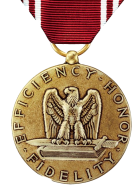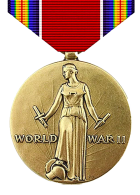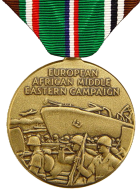This narrative is dedicated to my wonderful daughter, Marie Bailey, who has been urging me to write about my active service in the United States Navy during the War. I have extended the time frame for these reminiscences to include the twenty-five troubled and turbulent years, 1925-1950, to provide a better understanding of how the events of that quarter century influenced a young man.
FORMATIVE YEARS
I was born in Portland, Oregon. My parents were Irven and Lydia Jensen. As a trivia note, this date February 9, 1925, when I was born, was the 60th birthday ofmy grandfather, Andrew Jensen - quite a coincidence. I understand he drove his Model T Ford in a heavy rainstorm from his farm near Oregon City to welcome his first grandchild at Eivers Maternity Hospital. My early childhood was probably typical of a family struggling during the Great Depression. My father was often unemployed, finances were tight, and my mother did housework to earn some income. We never went hungry, and I always received warm parental care and love.
ELEMENTARY SCHOOL
Grades 1 - 6 were at Beaumont, on NE Fremont Street; and grades 7 and 8 at the logging camp at Valsetz. School was a pleasure; it was always a happy time with many excellent teachers. Another positive influence was the YMCA for swimming, camping, athletics, group activities: all of which were learning experiences. One common recreation was Saturday at the movies. I would go to the "Y" in the morning, pay 15 cents for a burger and shake for lunch, and then 10 cents for the matinee which included two features, a newsreel, cartoons, and a serial. This gave Mom a free day for 25 cents and on to New York City where I boarded it along with the rest of the crew. In short, an LST was not a pretty vessel, but very functional.
FIRST DAYS ON THE LST-500
Finally we were underway, out the East River, under the Brooklyn Bridge and through the Cape Cod Canal to Boston for final loading. On the twoday trip to Halifax, I was violently seasick, plus we encountered icebergs; Uboat alerts kept us at G.Q. Battle Stations several times. A very miserable introduction to sea duty! While in Halifax, we enlisted men had a challenge basketball game against the officers. Ensign Nick Skorich, a football player and later head coach of the Cleveland Browns, gave me a hip, and I went flying into a concrete wall: needless to say, the officers creamed us. Mr. Skorich was a good officer and a great leader. Halifax was an assembly port in both world wars for convoys to Europe. It was a bleak, dreary place in winter. We carried general cargo in the tank deck, an LCT (Landing Craft Tank) topside with an LCM (Mechanized Landing Craft) inside the LCT, some trucks, six small boats with those 24 sailors, and a contingent ofNavy medics: a big load.
CROSSING THE ATLANTIC
Finally to sea, and I was never seasick again. My battle station was pointer on a 20mm gun, and I wore wool clothes, jacket, parka, gloves, cap, helmet, Mae West life jacket, boots, and heavy sox. All this was really bulky, but it is always cold in the North Atlantic. En route we seldom saw any escort destroyers, but we had many calls to G.Q. because of U-boat activity. One night our convoy lost two oilers to torpedoes. During the long cold nights we had plenty of coffee, and I picked up smoking, a terrible habit, which I quit cold turkey in 1950. After fourteen days in rough weather, we arrived safely in Glasgow, Scotland, in early April.
IN THE U.K. BEFORE D-DAY
We were in Glasgow for five days unloading most of the cargo and getting re-supplied. While there, I accompanied the Supply Officer by rail to a U.S. base to obtain British money for our payday. That was a nice trip down the scenic Firth of Clyde on which fjord the Queen Mary and Queen Elizabeth were constructed. Then to Milford Haven, Wales, which is still an oil supply depot. After one night here, we went around Land's End into the English Channel to Plymouth, a port that had been heavily bombed for years. We unloaded the LCT in Falmouth - a tricky maneuver where the ship was tilted at about a 30-degree angle in order to slide the craft over one side. For four years since the miraculous evacuation from France in 1940, plans had been moving forward for an invasion which required a build up of troops, equipment and training on an immense scale.
One training mission, "Exercise Tiger" with eight American LSTs and only one British Escort, held on April 27-28, near Slapton Sands, was a terrible disaster. German E-boats (German motor torpedo boats, called E-boats) sank two LSTs with an official 749 soldiers and sailors killed. Somehow we were not in this event; I believe we were undergoing minor repairs. This debacle was hushed up for forty years. At the time, we knew about it and were instructed to ke'ep quiet, but the mistakes made were corrected, and the Utah Beach landings six weeks later went quite smoothly.
June 6 1944, D-Day Invasion
We began loading elements ofthe 4th Infantry Division on May 31st in Plymouth near where the Pilgrims embarked in 1620. Then we moved on to the Dart River, near Salcombe, where we were to wait for D-Day. On the tank deck we carried DUKWs, which were amphibious trucks; topside we had other trucks, Jeeps and Army equipment plus ammunition, fuel, and all kinds of supplies. We were really crowded with soldiers sleeping everywhere, and we had Navy small boat crews and some 40 medics. We also towed a barge, carried pontoons, lofted two barrage balloons, and I don't know what else. We left on the evening ofthe 4th of June, but bad weather delayed Operation Overlord for 24 hours. Out again on the 5th , following clearly marked lanes across the English Channel. I was stationed on No.1 Gun Tub in the bow on twin 40 mm guns, so I had a great view ahead. Everyone was nervous and scared; our Bos'n in charge, George Lavoie, an older man, helped to keep us kids loose, but it was a long night approaching the unknown whether we would face a concrete and steel Atlantic Wall or something else.
At dawn there was lots of action at sea and in the air. For a time we were close to a battleship which was firing 14" shells - that was spectacular. Hundreds of ships and boats milling about; and in the air Allied planes were ,identified with black and white stripes painted on each wing and the fuselage. We never saw any German planes that day, and our anti-aircraft guns were silent. During D-Day itself activities on our ship stabilized. I know we had some time to relax and chow down. By midday we seemed to be in a calm area we had no awareness of what was going on elsewhere such as the near disaster at Omaha Beach. Being at a high latitude, plus the double daylight savings time, nightfall at 10:30 finally gave us some quiet time. The previous 48 hours had been very tense.
On the next day we completed unloading offshore, DUKWs into the water and offloaded other stuff on to small crafts and barges. As a designated hospital ship, we did receive a few wounded; one man died before we returned to Portland Harbor at Weymouth, where we loaded up again. On this second trip we unloaded on Utah Beach. Ernie Pyle, the noted war correspondent, boarded an LST in Falmouth and landed at Omaha Beach on D+1, June 7, where he described the shoreline as "a museum of carnage."
His dispatch read in part: We aboard this ship had dreaded the trip, for we expected attacks from U-boats, E-boats, and at nighttime from the Luftwaffe aircraft. Yet nothing happened. Minesweepers had cleared wide lanes across the English Channel. Pyle wrote much more from Normandy and later in the Pacific where he was killed. Pyle also wrote: The wreckage of war is vast and startling. The awful waste and destruction of war, even aside from the loss of human life, has been one of the outstanding features. To those who are in it, anything and everything is expendable. And we did expend on our beachhead in Normandy during those first few hours.
D-DAY TO V-E DAY
Over the next eleven months we completed about 50 round trips between England and France, loading at various ports and discharging at Utah, Omaha, Le Havre, Cherbolirg, Rouen, Mt. St. Michel and other places. Usually we sailed during the nighttime hours. We transported tanks, trucks, ammo, fuel, food and many soldiers most ofwhom became seasick. The LST-499 was torpedoed and sunk near us, but most of the danger was from mines because the German air and sea power had been wiped out. However, on land the German Army in the famous hedgerows stalemated our advance. Finally, during the breakout at St. Lo, we saw thousands of planes flying over us to soften up the enemy lines. On one trip in August we carried a big load of artillery shells to the beach at the base of Mt. St. Michel, the Monastery Rock. Tides here vary as much as 30 feet, so our LST was on an immense mudflat for 12 hours. Townspeople came down to visit us, and we showered them with candy and cigarettes. This was near St. Malo, a port the American army surrounded, thus isolating the German garrison. Several-other big ports in western France were also bypassed until the end of the war.








